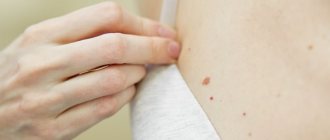During pregnancy, a woman's body changes under the influence of the endocrine system. As a result, in the first semester, the pregnant woman experiences sudden mood swings, perversion of taste and other symptoms characteristic of this period.
However, not only the internal state of a woman changes, but her body also undergoes serious changes. Small cracks appear on the skin of the abdomen and chest, which increase in length over time. Their relief can be lumpy or smooth, and the color changes in accordance with the stage of development of the striae.
Why do stretch marks appear during pregnancy? How to prevent their development? How to remove stretch marks on the skin if they have already appeared? What modern cosmetic methods allow you to get rid of them forever?
What are striae?
Stretch marks are small defects that form on the surface of the skin. They often appear in the thighs, abdomen, chest and buttocks. Externally, they appear as parallel or radial long strips that differ in color from the surrounding skin.
Initially they are red in color due to congestion of the vessels. As they become deserted, the striae first acquire a purple tint, then become white. They are called "old" stretch marks, the color changes 6 months after their appearance.
Due to a decrease in collagen and elastin, gaps form in the skin, which are replaced over time by connective tissue. They do not contain pigment, so when the skin tans, stretch marks become more noticeable.
How to choose a bandage for a pregnant woman
Modern manufacturers produce a fairly large number of products to support the belly of a pregnant woman.
Types of bandages for pregnant women
The main difference between the bandages that are on sale today is the version. The following are considered the most popular:
- The belt is a fairly wide elastic band that is secured under the stomach with a special Velcro fastener. Some models are equipped with additional valves for adjustment. This support product perfectly supports the uterus in a fixed state. They wear a belt over their underwear.
- Briefs look like regular underwear, but have special inserts that help support your belly. The same inserts are provided at the back to support the lower back. When choosing this type of product, you should take into account that the size of the abdomen regularly increases and you will often have to change the bandage to another larger one.
- Today the corset is practically not used. Firstly, putting it on is quite difficult, with lacing alone, especially difficult for a pregnant woman to cope with. In addition, it is ineffective when compared with similar products of other types.
- A combined bandage will be useful to a woman both during pregnancy and after birth. Outwardly it looks like a belt. On the one hand, the tape is quite wide, and on the other, it is narrow. During pregnancy, the narrow part of the bandage is placed on the stomach. After the baby is born, the bandage is worn with the narrow side on the lower back.
Modern bandages are made from highly hygroscopic materials, which ensure natural air circulation. This means that you can wear them without fear of skin irritation.
When to start wearing a brace
The need to wear a bandage can only be determined by a doctor. Usually, the bandage begins to be put on at the 22nd week of pregnancy. In some cases, the doctor may prescribe wearing an orthopedic bandage as early as the 15th week of pregnancy.
How to choose the size of a bandage for a pregnant woman
The need to wear a bandage is determined not by the pregnant woman, but by her doctor. Usually, the bandage begins to be put on at the 22nd week of pregnancy. But there are also exceptions. It may be necessary to wear an orthopedic bandage earlier, but not earlier than from the 15th week of pregnancy.
- If a woman prefers a belt, then she needs to focus on the sizes of clothes that were previously worn before pregnancy.
- Buy panties one size larger.
- A universal bandage is selected based on waist size plus 4-5 centimeters.
- Each manufacturer of bandages has its own size chart, so before purchasing it is better to read it on the product packaging.
How to use a bandage correctly
The main function of an orthopedic prenatal bandage is to support the abdomen while a pregnant woman moves. Doctors categorically do not recommend sleeping in a support product. During sleep, the entire body should rest, including the abdominal muscles. The bandage will prevent the muscles from relaxing, which is not very good for a woman. You can lie down to rest in it, but for no more than 15 minutes.
How to put on a bandage
The optimal body position before putting on a support product is lying on your back. In addition, it is important not to immediately put on the bandage, but to lie down for a long time so that the baby in the womb also has time to position itself correctly and comfortably. The bandage is put on slowly, without fuss or haste, and is securely fixed. It is important to ensure that the bandage does not press anywhere or rub even slightly.
How long can a pregnant woman wear a brace?
There is no need to wear a bandage all day. The product is worn before hiking and active activities. Doctors recommend not wearing the bandage for more than 6 hours. However, if you need to wear the product all day, you must take half-hour breaks every 4 hours. At the same time, it is imperative to monitor the cleanliness of the product, especially those models that are in direct contact with the skin.
Why do stretch marks appear during pregnancy?
Stretch marks can appear on a pregnant woman’s body for several reasons:
Changes in hormonal levels. During pregnancy, the production of estrogen and cortisone decreases. As a result, the production of proteins (collagen and elastin) and elastic fibers located in the connective tissue is disrupted. At the same time, the skin loses its former tone and elasticity, and “dips” appear.
Sudden weight gain. During pregnancy, a woman gains weight - this is a physiologically determined process. However, if a pregnant woman gains over 5 kg in a short time, the skin quickly and incorrectly stretches. Small cracks form on its surface, which over time turn into a white scar.
Genetic predisposition. The hereditary factor is of great importance, therefore, stretch marks and other cosmetic defects do not form on the body of some women during pregnancy due to its high and rapid regeneration.
Insufficient skin care. Due to dryness, the skin loses nutrients and becomes tough. This is why it is important to moisturize your skin during pregnancy and after childbirth.
Weak muscles of the anterior abdominal wall. Due to low physical activity, stretch marks may appear on the abdomen. There are special exercises aimed at preventing the formation of stretch marks in the abdominal area, which will be discussed below.
In addition, due to poor nutrition, the content of vitamin E, or tocopherol, which protects the skin from damage, decreases in the pregnant woman’s body.
How do stretch marks appear?
Stretch marks form on the skin not only during pregnancy. Cosmetic defects, or stretch marks, can appear on the skin in adolescents, when gaining muscle mass, as well as in certain diseases (Cushing's syndrome, Marfan).
At first, a pregnant woman is bothered by itching on the skin, and scratches appear on its surface. Over time, small slit-like defects form that protrude above the skin. Sometimes their formation is asymptomatic; women notice them after the formation of a white scar.
How long does it take for stretch marks to appear?
During pregnancy, stretch marks on the abdomen often appear in the second trimester. This is due to a sharp increase in the belly of the chest due to the active growth of the child and hormonal changes. It is possible to prevent the appearance of stretch marks if you spend enough time on prevention.
Risk factors for stretch marks
Why do stretch marks appear on the skin? In addition to the main reasons listed above, there are factors that increase the risk of stretch marks on the skin of the thighs, chest and abdomen. Among them:
- Multiple pregnancy of the mother. Moreover, during pregnancy, the abdomen increases significantly in a short period of time, as a result of which the skin does not have time to recover and defects occur.
- A large fetus may also increase the risk of stretch marks on the skin of the abdomen.
- The age of a pregnant woman is an important factor in the formation of cosmetic defects on the surface of the skin. With age, it loses elasticity and firmness.
That is why the older a woman is, the higher the risk of developing stretch marks during pregnancy.
The hereditary factor also plays an important role in the formation of stretch marks, as mentioned above. If there are pronounced stretch marks on the skin of a pregnant woman’s mother in the abdomen and chest area, the expectant mother is likely to have them as well.
Why stretch marks occur
An increase in the size of the fetus and an increase in body weight provoke severe stretching of the woman’s skin, which leads to tissue rupture. Stretch marks during pregnancy occur due to the destruction of the reticular layer of the dermis.
Causes of stretch marks: poor diet; bad habits; lack of moderate physical activity; low physical activity; chronic swelling; cardiovascular or endocrine diseases. Lack of protein in a pregnant woman’s body is one of the main causes of rupture of connective tissue fibers. A lack of protein stops the production of the natural “building” element of tissue - collagen. This makes the skin less elastic and firm. In order for a pregnant woman’s body to receive as much protein as possible, it is important to regulate nutrition and make it complete and balanced.
How to prevent the appearance of stretch marks on the skin?
During pregnancy, it is important to follow the principles of prevention that will protect the skin from stretch marks. First, you need to add foods rich in vitamin E and C to the pregnant woman’s diet. Legumes are rich in vitamins and minerals, as well as green vegetables. You should give up sugar, it reduces the formation of collagen in the skin.
It is also necessary to monitor your water balance. If the pregnant woman is not bothered by body edema and there are no special recommendations from the supervising doctor, it is recommended to drink at least 1.5 liters of water per day. It is also necessary to monitor the nutrition of the skin, moisturize it with special creams and lotions, and use a hard-bristled brush when washing.
Moderate physical activity increases muscle tone. For this purpose there are special group classes in the gym. Women during pregnancy usually practice yoga. If physical exercise is contraindicated for health reasons, you should spend more time walking at a brisk pace.
How to get rid of stretch marks if you already have them
There is definitely no way to quickly reduce stretch marks - for proper cell regeneration, breakdown of excess collagen fibers and sufficient penetration of a special anti-stretch mark product deep into the epidermis, you will need to undergo a full course of treatment.
Physiotherapy and special aids
The procedures can be either simple applications of Fermenkol against stretch marks, or its combination with physiotherapy, for example, with electrophoresis - the choice of method for treating stretch marks depends on the degree of its complexity, the desired result and the presence of contraindications.
You can start treating stretch marks at 3-4 weeks , rubbing the product into the problem area with massage movements. However, before use, make sure that there is no allergy to the drug. To do this, just apply a small amount of cream to your palm and leave for 20 minutes. If there is no redness, feel free to use it.
Before starting a course of physical therapy, make sure that the chosen method is suitable for you, consult with your doctor.
Treatment can also be combined with light physical activity: gymnastics, walking, swimming will help to “accelerate” the blood, saturate the cells with oxygen and make the muscles elastic.










